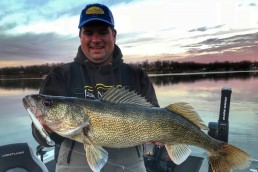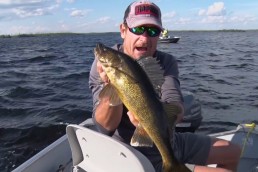Catching Walleyes on Jerkbaits
SHARE THIS POST
A jerk by any other name…
Jerkbaits can roll with a lot of different names. Twitch baits, minnow baits, sticks… jerkbaits encompass any slender-profile, shallow-running hard bait that looks like a minnow. The actions and characteristics vary dramatically among the vast number of lure models. The classic lure that started this lure category is the original Floating Rapala. It has a very subtle roll and shimmy. Other lures on the scene include the Smithwick Rogue, the Rapala Husky Jerk and X-Rap, Lucky Craft Pointer Minnow, Mega Bass Vision and the Salmo Rattlin’ Sting.
These lures can be fished to extremes. From slow steady retrieves importing slight wobbles to a steady retrieve interrupted by pauses and stalls. At the other extreme, some of these lures handle slashing speeds. Anglers snap them forward to get the lures to erratically slide in one direction. Then, with another rip, they make them slide off to the opposite direction.
Lures designed for these sharp snaps have a much more aggressive action. Anglers snap the lure forward with a much faster retrieve that might include three rapid snaps during a reel revolution. The lure snaps forward rapidly, stopping and hanging momentarily between snaps. It stalls again momentarily as you bring your rod back towards the lure. The best lures ride almost perfectly horizontal when stalled. Many recent lure designs feature sliding weight transfers that facilitate longer casts. The new Salmo Rattlin’ Sting has been called an absolute jerkbait masterpiece by many astute walleye and bass anglers just because this particular lure does many things well.
Cast for bass, troll for walleyes
Traditionally, bass anglers cast jerkbaits while walleye anglers troll them, spring and fall. Both types of anglers want to cover water. Trolling jerkbaits along riprap or over shallow sand, gravel and rock contours catches big walleyes every year. Another productive pattern works these lures over flats and shoreline tapers that have emerging weed growth in less than 10 feet of water.
Walleye anglers have cast these same lures for years, particularly while wade fishing in the spring and fall around riprap, current bottlenecks and gravel. Now, more walleye anglers take plays from the bass-fishing handbook by casting these lures in other situations. Casting or trolling jerkbaits each has advantages and disadvantages for targeting walleyes.
Trolling shines whenever fish relate to large, mostly featureless locations and spread out over broad areas. It’s also is good whenever you are in search mode, covering a new area quickly. Trolling jerkbaits can also rule when fish are 5 to 10 feet deep and won’t rise to a bait.
Casting can be more effective when fish stack up against a shoreline. It’s the ticket when fish are less than 5 feet deep or positioned higher in the water column after dark or during wind. Casting is also much more efficient when fish are on the spot on the spot, which is often the case when fish are on rock or relate to weed clumps.
Trolling is a broad brush and casting is precise. With the advancements in spot-locking features on trolling motors and anchoring devices like Talons and Power-Poles, precise fishing is easier than ever.
Are you enjoying this post?
You can be among the first to get the latest info on where to go, what to use and how to use it!
Trolling or casting jerkbaits
Early in the season before the water hits 60 degrees, I catch more fish trolling jerkbaits, pulling the boat with the bow-mount trolling motor. Trolling with an electric trolling motor lets me creep along at slower speeds ranging from 1 to 1 1/2 mph. In extremely clear water, I often use planer boards, monofilament line and make a lot of S curves with the boat. Early in the year, fish seem much spookier but as the water temps rise, I can get away with a lot more. As the summer progresses I can pick up my speed to well over 2 mph. Throughout the year I often catch more fish with the rod I hold by pumping and stopping the lure. Many hits come on the turn or when the lure pauses after a snap or pump forward.
Wind or weeds combined with shallow fish mean casting jerkbaits. Change up your retrieve speed and cadence; methodically fish every cast a little differently to find the groove the fish hit. It is really easy to fish these lures too fast for walleyes and I have to keep reminding myself to slow down. Subconsciously, we tend to fish faster when we are excited. I fish faster after catching a fish so I must watch my speed vigilantly. Finding that zone each day is paramount. I have every angler in the boat use the exact same rod and reel so that if somebody starts hooking up, we can match the retrieve speed by watching the successful angler.
Going for distance
When fish are a little off, long casts often catch more walleyes, which are notorious for following and pecking at the back of the lure for a considerable distance. Fish often follow the lure out over deeper water. When the fish are aggressive, short casts allow you to make more casts right into the zone. When fishing over emerging cabbage or pencil reeds, fish high and make the fish come up for the lure—you won’t catch anything if the lure is fouled up.
As the weeds grow higher, we use shallower lures to stay above them. Strong wind and waves can also turn on a jerkbait bite. As a rule of thumb, the sweet spot for running depth is double the height of the wave. In other words, in three-foot swells, try to run lures about six feet down. However, big fish have no problem riding the turbulence right below the surface. Strong wind over rock or a hard bottom is typically an opportunistic pattern where casting or trolling jerkbaits shines.
While mono works great for slowly presenting jerkbaits early in the season, as the water temps heat up over 65 degrees and fish respond to more aggressive cadences and faster speeds, try braided line with a fluorocarbon leader. This combo gives the lure a much more pronounced action and works great for snapping off weeds.
Jerkbaits have been in tackle boxes for decades and now are becoming more popular among mainstream walleye anglers for casting. New lure designs trigger fish consistently throughout the year. Whenever fish are shallow, jerkbaits can find fish much more quickly than many soft plastic lures and live bait presentations.
Jason Mitchell is a top walleye guide on Devils Lake, N.D. and hosts the TV program, “Jason Mitchell Outdoors.” Visit jasonmitchelloutdoors.com for more.
Looking for a new fishing challenge? Check out our article on Finding Remote Saskatchewan Lake Trout!
MWO
SHARE THIS POST
Did you enjoy this post?
You can be among the first to get the latest info on where to go, what to use and how to use it!
Jason Mitchell
Jason Mitchell was a top walleye guide on Devils Lake, N.D. for nearly 20 years. Today, Mitchell produces the Jason Mitchell Outdoors TV program. Visit jasonmitchelloutdoors.com for more.



